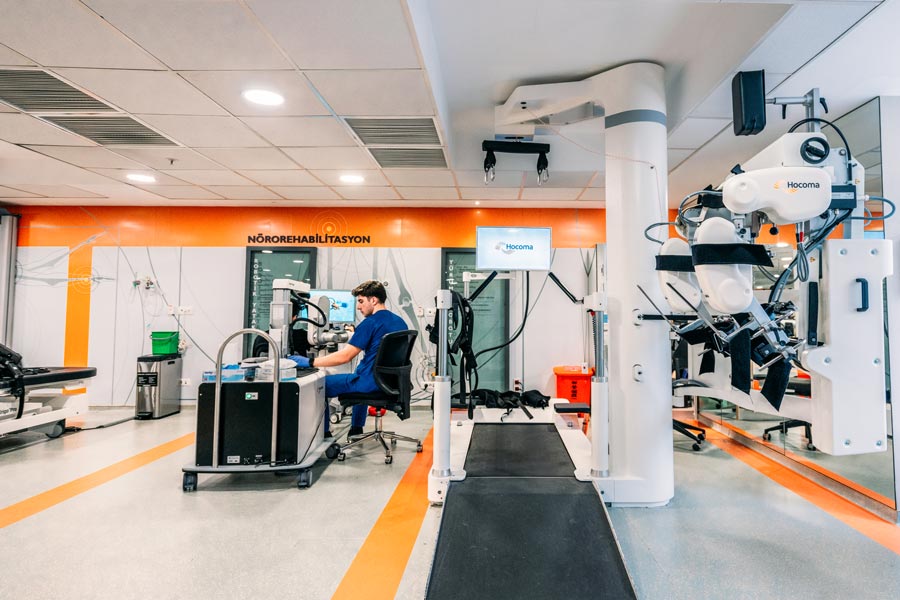Brain hemorrhage means the spread of blood into the tissues in brain due to the rupture of one of the veins in the brain. This bleeding causes death of the neurons by pressurizing the tissues. 10-15% of all the strokes are caused by brain hemorrhage. Brain hemorrhage can be stated as cerebral hemorrhage, subdural hemorrhage or subarachnoid hemorrhage according to the area where it happens. The clinical situation is also shaped according to the area where the hemorrhage happens.
Why Does Brain Hemorrhage Happen?
Brain hemorrhage happens most frequently because of high blood pressure. The continuation of high blood pressure for a long time weakens the blood vessel walls and makes them exposed to rupture. This kind of brain hemorrhage can be prevented if hypertension is taken under control.
- Another frequent reason of brain hemorrhage is head trauma. Brain hemorrhage due to head trauma is seen frequently especially in the persons under the age of 50.
- Formation of a bubble because of the weakness on the blood vessel walls (aneurism) and the bursting of this bubble can also cause brain hemorrhage.
- Abnormal shape and weakness of the blood vessels, bleeding disorders, excessive alcohol consumption and substance usage may also cause brain hemorrhage.
Cerebrovascular accident or cerebrovascular disease expresses a series of disease when the blood stream is prevented. This situation may disturb brain functions temporarily or permanently. If cerebrovascular embolism or cerebral hemorrhage prevents the neurons from receiving sufficient oxygen, brain injury may ensue.
Recovery Process after Brain Hemorrhage
Recovery process after brain hemorrhage may happen differently in every patient. Suitable treatment methods should be designated according to this period. Because of this reason, brain hemorrhage recovery process is an intricate phenomenon which necessitates the mutual striving of many medical specialties and health professionals.
The most crucial factors which affect the recovery process after brain hemorrhage are the location and severity of the bleeding, making the intervention promptly and correctly, and physical therapy and rehabilitation.
40 per cent of the patients who had brain hemorrhage die within the first month. Severe disability happens in half of the patients who survived after the brain hemorrhage. Patients may need intensive care initially in case of brain hemorrhage. Coma, dyspnea and need of making the patient sleep because of brain hemorrhage necessitate a follow-up in intensive care. Medical operation may be needed to lessen the pressure which increased within the head because of the bleeding or to stop the bleeding. In other cases, the process can be taken under control via medication.
In case of brain hemorrhage, better results are obtained with early treatment. Obtaining results with physical therapy in patients who have better understanding, capacity to learn and ability to participate the active treatment according to their overall conditions is higher. Recovery after brain hemorrhage may differ according to the area where the brain is affected and the severity of the impact. In case of mild paralysis, recovery is observed within 3-6 months generally. On the other hand, improvement of the sensitive hand gestures which are called as fine motor skills may take more time. In case of more severe paralysis situations, recovery process may take a couple of years or permanent disabilities may be seen.
Physical Therapy and Rehabilitation in Brain Hemorrhage

Physical therapy and Rehabilitation applications start from the earliest period in the patients who has overcome the life-threatening situation and whose overall situation became stable.
- Positioning and passive joint range of motion exercises are applied to prevent the development of pressure sores, joint stiffness and muscle shortness even if the patient is still in intensive care or with unconsciousness.
- In case of the patients with consciousness and volitional movements, active exercises applied next. Especially the exercises and methods which stimulate neuroplasticity, which is brain’s potential to recover, are used in this stage
- Electric stimulation is applied to prevent muscle loss and strengthen the muscles.
- It is tried to make the patient gain in-bed movement and sitting balance on the edge of the bed.
- Standing afoot and walking exercises are started in case of the patients whose muscle strength and sitting balance are suitable.
- Ergotherapy is applied to develop the daily life activities and dexterity and to increase the cognitive skills.
- Respiratory physical therapy, speech therapy and swallowing therapy are included in the treatment if necessary.
- Orthoses may be used to prevent joint stiffness or to enable walking.
As you see, recovery process after brain hemorrhage necessitates an experienced-special team and multidisciplinary teamwork. During the physical therapy and rehabilitation process, physical therapy and rehabilitation specialist doctor coordinates the team. Health care professionals like physiotherapist, ergo therapist, physical therapy technician, rehabilitation nurse, dietitian, speech-swallowing therapist, respiratory therapist and orthosis- prosthesis technician are involved in the team. Other specialties and health care personnel can also join the team according to the situation of the patient.
Click to get detailed information about stroke treatment.
Robotic Physical Therapy in Brain Hemorrhage
Physical therapy of brain hemorrhage is consisted of intense, repetitive and task-oriented movements. The exercises which meet these criteria develop arm and leg functions of the patients who had paralysis caused by brain hemorrhage. An important way of reaching the needed exercise intensity of brain hemorrhage treatment is usage of robotic devices. These applications are named as robotic physical therapy or robotic rehabilitation.
Robotic Bed Erigo Pro is quite useful for the bringing the patient to feet and move in an early period. It enables the patient to be brought to the upright position and walked passively with robotic equipment in control. Ensuring this early-period passive walking helps to prevent the problems like advanced cardiovascular problems and joint stiffness which may be caused by remaining in bed for a long time. It caused increase of the patient attention to the environment and prompts the eagerness to socialize.
With the Gait Robot Lokomat Pro, patient can be brought to feet and made to perform movements closest to natural walking. The movement which the patient could not make is completed by the robot and thus, the relearning mechanism between brain and feet are stimulated. The patient can do walking exercises more motivated and for longer time by playing games like gold hunting on the screen.
Anti-Gravity Treadmill Alter G is used in the patients who reached a definite stage in treatment but still cannot walk independently and balanced. The body weight of the patient can be decreased up to 80 % per cent in comparison to gravity with anti-gravity treadmill. Because of this quality, it is named as space walk or moon walk by some patients. It compensates the weak muscle strength of the paralyzed patient in brain hemorrhage treatment; while the muscles strengthen, the self-confidence also increases. It also provides a safe environment by preventing fall; the patient gets rid of the fear of falling and gives their attention to walking.
With the Hand-Arm Robot Armeo Power, it is possible to apply the aim-oriented exercised to the patient with more intensity. Instead of repetition of the aimless movements, the exercises which imitate the daily life activities in the closest fashion are more effective in the treatment of paralyzed hand-arm treatment after brain hemorrhage. While the robotic device provides nearly full movement support for the patients who cannot move their hand and arm, it decreases the help it offers as the hand and arm function develops. This support which is given according to the need increases the patient’s participation and motivation in the treatment and stimulates the brain acutely to relearn the movement.


